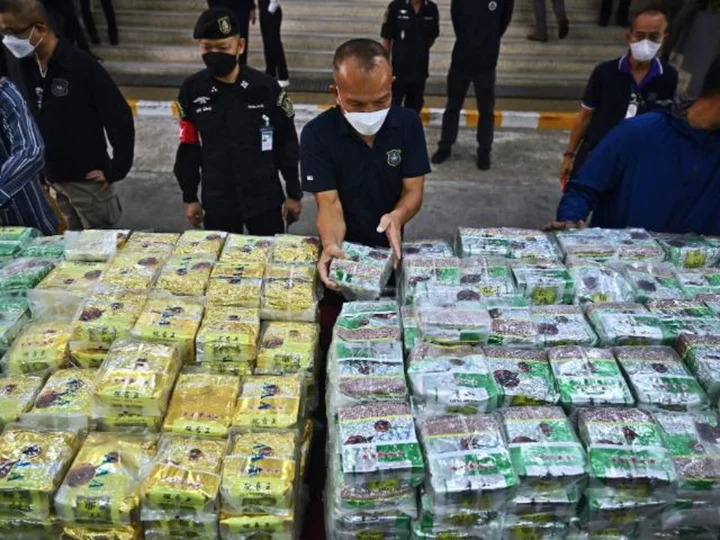The synthetic drug trade in Asia is roaring to "extreme levels," with crime groups establishing new trafficking routes to evade enforcement crackdowns and methamphetamine prices hitting fresh lows, according to a new report released Friday.
The research by the United Nations Office on Drugs and Crime (UNODC) found that meth seizures in East and Southeast Asia, which spiked to record highs during the pandemic as cartels switched to bigger and riskier bulk shipments, returned to pre-Covid numbers last year.
But other key indicators such as arrests, street availability, purity as well as low wholesale and street prices "indicate the supply has remained very high or unchanged," the report said.
And as pandemic border closures and travel restrictions began lifting, international criminal organizations began reconnecting, with "late 2022 and early 2023 patterns starting to look similar to 2019," said Jeremy Douglas, UNODC Regional Representative for Southeast Asia and the Pacific.
There are other signs of the drug trade bouncing back. Japan's customs officials saw a rise in air passengers smuggling methamphetamine in the second half of 2022, after the country reopened its borders. West African trafficking networks in East and Southeast Asia, which "all but disappeared" during the pandemic, have now resumed their activities, the report said.
"The most powerful regional trafficking networks are able to operate with a high degree of certainty they can and will not be stopped, and they are able to dictate the terms and conditions of the market as a result," the report warned.
Some countries have stepped up their anti-trafficking efforts in recent years. More stringent law enforcement in China's southwestern Yunnan province, and along the Thai border with Myanmar, has seen a significant drop in meth seizures in China and a slight decrease in Thailand.
But in turn, traffickers have adapted to "try to circumvent what governments do," Douglas said.
Andaman trafficking
Asia's drugs cartels generate billions through the global narcotics trade while generating a fraction of the attention of their counterparts in Latin and Central America, in part because they keep a much lower profile and are less prone to bouts of internecine warfare.
For years, the majority of regional meth production has taken place in the jungles of the Golden Triangle, a remote area where the borders of Thailand, Laos and Myanmar meet that has long been one of the world's key narcotic hubs.
The closely-watched area still sees large volumes of drugs pass through -- but crime groups are increasingly turning to western maritime routes, rerouting supply through central Myanmar to the Andaman Sea "where it seems few were looking," said Douglas.
From Myanmar, meth and other synthetic drugs then travel out to the world, with shipments previously found as far away as Japan, New Zealand and Australia. South Asia, too, is being pulled further into this market, with meth transported in "high volumes" from Myanmar to Bangladesh and northeast India, the report found.
Despite the government crackdowns and increased seizures, wholesale and street prices for meth fell to record lows across the region in 2022 -- a sign that that ample drug supplies were still getting through uninterrupted, according to the report. It also pointed to the high number of drug-related arrests and admissions at drug treatment facilities as further evidence of robust trade.
Other UNODC findings in recent years have painted a picture of a booming drug industry in Asia in spite of the pandemic, with some drug cartels taking advantage of distracted governments scrambling to contain the virus and enforce public health measures.
Organized crime groups have also capitalized on political instability such as the 2021 military coup in Myanmar and ongoing conflict in the country, which has made the country's already lawless border regions an even more ideal production and smuggling hub.
Surge in ketamine
Besides meth, the production and trafficking of ketamine is also rising rapidly in the region, with authorities seizing 27.4 tons of the powerful dissociative anesthetic often used as a party drug.
That figure is 167% higher than the previous year, according to the UNODC report. Nearly every country and territory in the region reported an increase in seizures, except Japan and Hong Kong.
"The ketamine situation in the region in many ways mirrors the supply-driven approach used to expand the methamphetamine market in the mid-2010s," said Inshik Sim, UNODC regional coordinator on synthetic drugs, in a news release.
"That being said, information on ketamine use is limited, and it is unclear how widespread it is -- research is badly needed."
Cambodia, long a transportation hub, has also begun to emerge as a key drug manufacturing location, with authorities discovering a series of secret industrial-scale ketamine labs, storage facilities and processing warehouses in the country.
The chemicals and equipment found in these labs point to a sprawling international network, originating or transiting from at least 12 different countries and provinces, the report said. For instance, there were chemicals found produced in France with Vietnamese writing on the packaging; other substances came from Poland, India, Indonesia and South Korea.
The sheer amount of chemicals found also point to a boom in ketamine production; Cambodian authorities seized 518 tons of chemicals in 2022, compared to just 5 tons in 2020, alarming international and regional leaders.

